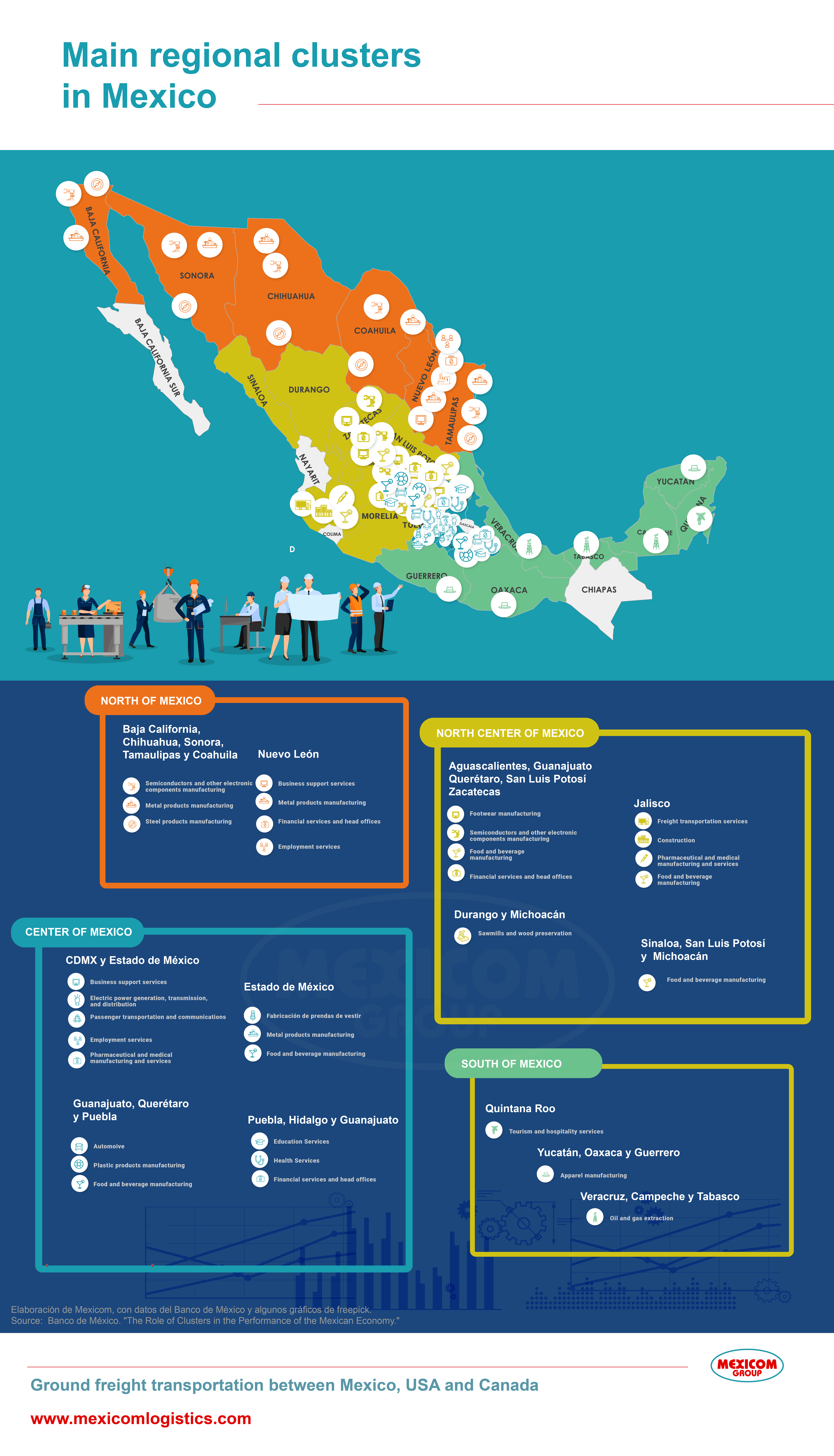Nearshoring: Current regional clusters in Mexico and their correlation with economic growth
In this post, we present an infographic that shows the concentration of industrial clusters in 4 regions of Mexico and the correlation between the growth of specific industries clusters and the economic growth, as presented by Banco de México, in its recent working paper “The Role of Clusters in the Performance of the Mexican Economy”.
Identification of clusters in Mexico
Clusters are geographic concentrations of interconnected companies and institutions that compete but also cooperate with each other (Porter, 2000).
The identification of clusters is subject to a very high level of discretion. While various methodologies can be useful for identifying clusters, they have some limitations in terms of capturing the spatial dimension of economic activity and require careful consideration of their assumptions and the type of variables used.
There are several documents that present different classifications of clusters in Mexico and that identify the areas where they are located. In 2017 the iCluster Map of Clusters (www.icluster.inadem.gob.mx) was presented, a digital geographic system with information for industrial sectors between Mexico and the United States. However, today it is not accessible.
In this post, we present an infographic that shows the concentration of industrial clusters in 5 regions of Mexico, as presented by Banco de México, in its recent working paper “The Role of Clusters in the Performance of the Mexican Economy”.
In the paper, Mexico is a country that has been divided into four regions, each with its own set of economic strengths and clusters.
How many clusters are in Mexico?
According to the Bank of Mexico paper “The Role of Clusters in the Performance of the Mexican Economy” Mexico is a country that has been divided into four regions, each with its own set of strengths and economic clusters.
Clusters in the Northern Region of Mexico
Some of the most advanced technological clusters are present in the northern region of the country, which has strong economic ties with the United States.
Baja California, Chihuahua, Sonora, Tamaulipas and Coahuila
Main Clusters:
- Semiconductors and other electronic components;
- Manufacture of metal products.
- Manufacture of steel products.
Nuevo León is the most developed state in this region and has 8 clusters in manufacturing and services.
Main clusters:
- Office administrative services,
- Metallurgy Manufacture of steel products,
- Financial services and head offices, and
- Employment services.
Clusters in the Central-North Region of Mexico
The north-central region is known for its manufacturing clusters, such as:
- Footwear manufacturing,
- Semiconductors and other electronic components,
- Food and beverage manufacturing and
- Financial services and head offices.
Jalisco has a significant presence of clusters related to manufacturing and services.
Main clusters:
- Freight transportation services
- Residential and non-residential construction,
- Pharmaceutical and medical manufacturing and services, and
- Manufacture of food and beverages.
Durango and Michoacan
Main cluster:
- Sawmills and Wood Conservation
Michoacan, Sinaloa and San Luis Potosi.
Main cluster:
- Food and Beverage Manufacturing
Clusters in the Central Region of Mexico
Mexico City and the State of Mexico have a strong presence in clusters related to services.
Main clusters:
- Employment services,
- Financial services and head offices,
- Office administrative services,
- Generation, transmission and distribution of electrical energy and
- Infrastructure construction,
- Passenger transportation transportation and communications, and
- manufacture of pharmaceutical and medical products.
Mexico state:
Traditional clusters like:
- Food and beverage manufacturing,
- Manufacture of clothing and
- Meanufacture of metal products
Guanajuato, Querétaro and Puebla have a significant presence of clusters related to manufacturing
Main clusters:
- Automotive,
- Manufacture of plastic products and
- Manufacture of food and beverages.
Puebla, Hidalgo and Guanajuato also have clusters related to services.
Main clusters:
- Financial services and central offices and
- Education and health services.
Clusters in the Southern Region of Mexico
Quintana Roo
Main cluster:
- Tourism and Hospitality Services
Yucatán, Oaxaca and Guerrero are states characterized by lower economic growth and low specialization in secondary and tertiary activities.
Main cluster:
- Apparel manufacturing
Veracruz, Campeche and Tabasco have abundant natural resources
Main cluster:
- Oil and gas extraction.
Correlation between the growth of specific industries clusters and the economic growth
The study summarizes the findings on the correlation between the growth of specific industrial clusters and the overall economic growth in Mexican municipalities.
Clusters with the highest economic growth and a positive correlation with local economic growth
The study found that clusters related to retail and eating services, food and beverage manufacturing, and plastic products manufacturing had the highest growth and positive correlation with local economic growth.
Clusters with less growth but with an impact on local economic growth
High-tech clusters, such as medical equipment and supplies manufacturing and semiconductors and electronic components, had a relatively more modest but important role in regional economic growth.
Clusters with lowest correlation with local growth
Conversely, clusters related to employment services, tourism and hospitality services, electric power generation and distribution, and passenger transportation and communications had the lowest correlation with local growth. Oil and gas extraction was non-statistically significant and present in a small number of municipalities.
Clusters in Mexico by Industry and its conection with Nearshoring
Automotive industry: This cluster is one of the most important in Mexico, accounting for 3.9% of the country’s GDP and employing over 800,000 people. It is mainly located in the central and northern regions of the country. Mexico is one of the top 10 car producers in the world, with major car manufacturers like Ford, General Motors, and Volkswagen operating in the country. Nearshoring in this cluster involves the production of automotive parts and components.
Aerospace industry: This cluster is a growing sector in Mexico, with significant investments in recent years. It is mainly located in the northern regions of the country, particularly in the states of Chihuahua, Nuevo Leon, and Sonora. Mexico has become a prominent player in the aerospace industry, with over 300 aerospace companies operating in the country. Some of them preacticing nearshoring that involves the production of aerospace components and parts.
Electronics and electrical appliances: This cluster is mainly concentrated in the central region of Mexico, particularly in the states of Mexico City, Jalisco, and Guanajuato. Nearshoring Connection: Mexico’s electronics industry has attracted investment from foreign companies, including IBM, Intel, and HP, who have established manufacturing facilities in the country to take advantage of the skilled workforce, low costs, and proximity to the US market.
Textiles and clothing: This cluster is mainly located in the central and northern regions of Mexico. Nearshoring has contributed to increased exports of textiles and clothing from Mexico to the United States, particularly in the high-value-added segment of the market.
Sources:
Porter, M. E. (2000). “Location, Competition, and Economic Development: Local Cluster in a Global Economy”, Economic Development Quarterly, 14(1), p. 15-34.
Banco de México. (2018). Análisis de clusters en México: Un enfoque de econometría espacial (No. 2018-08). https://www.banxico.org.mx/publications-and-press/banco-de-mexico-working-papers/%7B80FDD837-A4EB-5232-9EA6-9F8C18E5F0D3%7D.pdf
“The Aerospace Industry in Mexico: A World of Opportunities”, ProMexico (https://www.promexico.mx/work/models/Promexico/ResourceLibrary/Publication/5225/1/images/Aerospace_Industry_Mexico_World_Opportunities.pdf)
Chat GPT Personal chat










